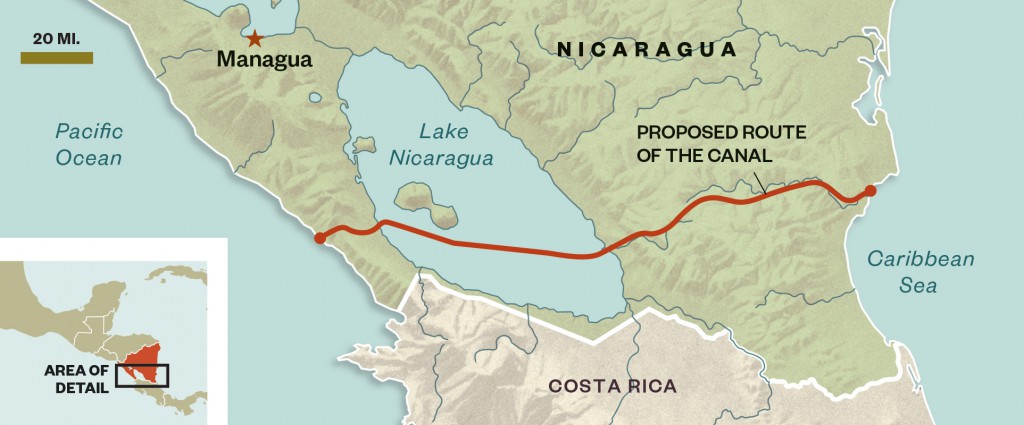Risky Nicaragua Canal Mega-Project

HAVANA TIMES — The Nicaraguan government gave a little known Chinese businessman a 100 year+ concession to build and operate an interoceanic canal dividing the country from west to east. Besides the canal itself, the consortium (HKND) has the right to purchase property anywhere it so decides for well below market value and keep it even if the canal isn’t built.
Sub-projects include highways, deep water ports, airports, free trade zones, tourist centers etc. The government of Daniel Ortega signed away any citizen rights under the Nicaraguan constitution to appeal decisions of the consortium.
Construction is slated to begin in late December, announced HKND last Thursday. The decision on the canal took place without considering independent environmental impact studies.
The following article from Smithsonian Magazine presents some of the issues involved.
A New Canal through Central America could have Devastating Consequences
By Matthew Shaer (Smithsonian Magazine)
HAVANA TIMES — The ramifications of the proposed route have environmentalists worried, and for good reason. The Nicaraguan government has yet to release promised analyses of the canal’s likely environmental impacts, and has even dodged neighboring Costa Rica’s request to share disaster plans. The canal’s true costs/benefits can’t be calculated as long as the costs to Nicaragua’s forests, waterways and wildlife remain hidden.
When construction crews begin digging a new canal next month across Nicaragua, connecting the Pacific and Atlantic, it’ll be a boon to global shipping and, the government says, to the economy of the second-poorest nation in the Americas. But activists, scientists and others are increasingly alarmed by the environmental impact of a 173-mile artificial waterway—wider, deeper and three and a half times the length of the Panama Canal.

Developed by Wang Jing, an enigmatic Chinese industrialist with ties to China’s ruling party, the Grand Nicaragua Canal will cost an estimated $40 billion and take five years to build. At 90 feet deep and 1,706 feet across at its widest, the channel will accommodate the newest cargo supertankers, which are longer than the Empire State Building is tall and carry 18,000 shipping containers. The vessels are too big to pass through the Panama Canal (even after a $5 billion expansion is completed) or to dock in any U.S. port.
The new canal and its infrastructure, from roads to pipelines to power plants, will destroy or alter nearly one million acres of rainforest and wetlands. And that doesn’t include Lake Nicaragua, a beloved 3,191-square-mile inland reservoir that provides most Nicaraguans with drinking water. The canal cuts through the lake, and critics say ship traffic will pollute the water with industrial chemicals and introduce destructive invasive plants and animals.
Plus, the canal route lies in the middle of a hurricane belt, says Robert Stallard, a research hydrologist with the U.S. Geological Survey and the Smithsonian Tropical Research Institute. “You’re likely going to be looking at hurricanes vastly more powerful than anything that ever hit Panama, and ever will,” Stallard says. A storm like Hurricane Mitch, which killed 3,800 people in Nicaragua in 1998, would probably cause the canal to flood, triggering mudslides that would breach locks and dams. Communities, homes, roads and power lines would be swamped.
The Nicaraguan government has yet to release promised analyses of the canal’s likely environmental impacts, and has even dodged neighboring Costa Rica’s request to share disaster plans. “We’ve got a lack of information and a potentially big threat to the environment,” says Jorge A. Huete-Pérez, vice president of the Academy of Sciences of Nicaragua. “The government just wants to rush the thing through.” The canal’s true benefits can’t be calculated, Huete-Pérez and others argue, as long as the costs to Nicaragua’s forests, waterways and wildlife remain hidden.






Ironically, in Club Socialismo, the Castros and Ortega are barely friendly. Their differences date back to Ortega’s first administration as President of Nicaragua. When then first-term President Ortega scheduled a Presidential election for 1990, it was Fidel Castro who commented at the time “Why hold an election you might lose? Ortega lost and there has been bad blood ever since.
This decision by Ortega demonstrates clearly that environmental concerns are of no interest to Socialist powers. No doubt the Castro family regime is hoping that somehow the construction of such a canal will provide some business for Mariel which currently is a pachyderm of the blanco type. However on the bright side it is unlikely that Ortega as a buddy of the Castro family regime would prevent the illegal shipping by the Castro family regime of armaments to another buddy, Kim Jung Un, the gout suffering pudgy dictator of North Korea.
As the Castro Ruz brothers have proved Socialist “Presidents” cannot be guilty of corruption so Noreiga will be quite safe.